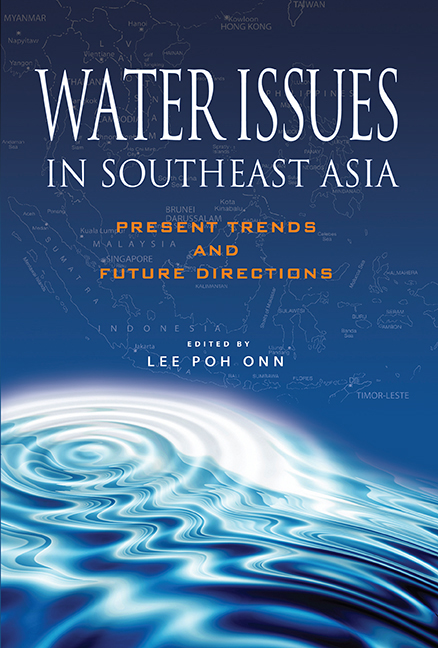Book contents
- Frontmatter
- Contents
- List of Tables, Figures, Boxes and Photos
- Acknowledgements
- About the Contributors
- CHAPTER 1 Introduction
- CHAPTER 2 China and the Potential for Conflict over Water among Eurasian States
- CHAPTER 3 River Basin Agreements as Facilitators of Development
- CHAPTER 4 Privatization of Water Services via Public-Private Partnership and Implications for Southeast Asia
- CHAPTER 5 Indonesia's Water Management Reform
- CHAPTER 6 Water Resource Management Issues in Malaysia
- CHAPTER 7 Privatization Issues in Water Supply in Malaysia
- CHAPTER 8 Troubled Waters: Rehabilitating the Pasig River, the Philippines
- CHAPTER 9 The Privatization of Water Services in Metro Manila: Lessons from a Mixed Outcome
- CHAPTER 10 Singapore's Experience in Water Resource Management
- CHAPTER 11 Thailand's Water Sector: Overview and Implications
- CHAPTER 12 Water Resources and Issues Concerning Sustainable Watershed Management Practices in Vietnam
- Index
CHAPTER 7 - Privatization Issues in Water Supply in Malaysia
Published online by Cambridge University Press: 21 October 2015
- Frontmatter
- Contents
- List of Tables, Figures, Boxes and Photos
- Acknowledgements
- About the Contributors
- CHAPTER 1 Introduction
- CHAPTER 2 China and the Potential for Conflict over Water among Eurasian States
- CHAPTER 3 River Basin Agreements as Facilitators of Development
- CHAPTER 4 Privatization of Water Services via Public-Private Partnership and Implications for Southeast Asia
- CHAPTER 5 Indonesia's Water Management Reform
- CHAPTER 6 Water Resource Management Issues in Malaysia
- CHAPTER 7 Privatization Issues in Water Supply in Malaysia
- CHAPTER 8 Troubled Waters: Rehabilitating the Pasig River, the Philippines
- CHAPTER 9 The Privatization of Water Services in Metro Manila: Lessons from a Mixed Outcome
- CHAPTER 10 Singapore's Experience in Water Resource Management
- CHAPTER 11 Thailand's Water Sector: Overview and Implications
- CHAPTER 12 Water Resources and Issues Concerning Sustainable Watershed Management Practices in Vietnam
- Index
Summary
INTRODUCTION
One of the growing trends in the global water industry is the transfer of the production, distribution, and management of water services from public entities into private hands — a process commonly known as “privatization”. The privatization of water encompasses a wide variety of possible water management arrangements. Privatization could be partial, leading to so called public/private partnerships, or to the total elimination of government responsibility for water supply systems except for its regulatory role. This chapter presents, in part, case study undertaken by Puncak Niaga in mid-2005.
As a measure of importance of privatization, the Second World Water Forum in March 2000 gave special emphasis to the need to mobilize new financial resources to solve water problems and called for greater involvement by the private sector. The “Framework for Action” released at the forum called for US$105 billion per year in new investment to meet drinking water, sanitation, waste treatment, and agricultural water needs up to year 2025. The framework also called for 95 per cent of this new investment to come from private sources.
In Malaysia, the National Water Resources Study Report produced in year 2000, which covers the planning needs up to year 2050, have recommended sixty-two water projects costing US$13.66 billion. The projects include the construction of fortyseven dams, large treatment plants and the transfer of water from one state to another.
The need for new development programme and investments coupled with the need to improve current condition of assets and service definitely requires substantial capital expenditures (CAPEX), which has become a fundamental problem in all privatization endeavours. In some cases, the rate of return in investment is not even adequate to even cover the operating cost, resulting in the accumulation of huge debts.
Such enormous tasks covering the aspect of developing, financing, managing and operating the water supply services have made it inevitable for private water operators to be more involved in the industry. New and innovative financing tools available to the private operators have also made it possible for them to undertake the transfer of responsibility for developing, managing and operating water supply services.
- Type
- Chapter
- Information
- Water Issues in Southeast AsiaPresent Trends and Future Direction, pp. 136 - 173Publisher: ISEAS–Yusof Ishak InstitutePrint publication year: 2012



